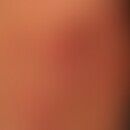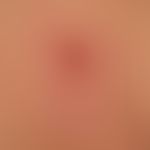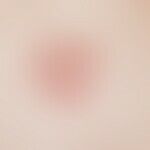Synonym(s)
Arning carcinoids; basal cell carcinoma erythematoides; Bowenoid basal cell carcinoma; eczematoid basal cell carcinoma; Epitheliomas Epitheliomas of the trunk skin; erythematoid basal cell carcinoma; Pagetoid basal cell carcinoma; Psoriasiform basal cell carcinoma; Superficial basal cell carcinoma; Superficial spreading basal cell carcinoma; Trunk skin basal cell carcinoma; Trunk skin epithelioma
DefinitionThis section has been translated automatically.
Preferably on the stem, very superficially located, plaque-shaped basal cell carcinoma.
EtiopathogenesisThis section has been translated automatically.
Mostly UV-induced. Today extremely rare: previous arsenic therapy.
You might also be interested in
LocalizationThis section has been translated automatically.
Mainly stem, but also extremities.
Clinical featuresThis section has been translated automatically.
Solitary or multiple, mostly asymptomatic (insofar as this is often a chance finding), slow-growing, sharply defined, 0.5-4.0 cm large, rarely as large as the palm of the hand, reddish-brown, slightly indurated, slightly scaly plaque with a discreet, shiny edge, especially when the skin is stretched. Especially when the surrounding skin is tanned, the lesions clearly appear as non-tanning negative images.
HistologyThis section has been translated automatically.
From the (mostly atrophic) epidermis, bud-like tumor proliferates from dense basaloid epithelial cells, which protrude into the papillary body. Palisade formation and cleft formation are usually detectable. Typical is a fibrous connective tissue surrounding the tumor buds with a mostly sparse, diffuse lymphocytic infiltrate. The connective tissue stromal reaction is helpful in assessing the lateral tumor boundary. If present at the edge of the incision (even without epithelial formations), a further tumor infiltration can be assumed.
Differential diagnosisThis section has been translated automatically.
M. Bowen; tinea corporis; psoriasis vulgaris, eczema, nummular
TherapyThis section has been translated automatically.
- In isolated tumours on the trunk vertical excision with a safety margin of 2-5 mm.
- In the case of multiple tumours on the stem, horizontal excisions with subsequent histological examination are permitted: e.g. curettage with a cutting curette, possibly combined with subsequent treatment with external cytostatics, e.g. 5-fluorouracil (Efudix®) every 2nd day for 1 week, thinly applied to the curetted areas, followed by gauze dressing. Cave! Apply to large lesions! Increased risk of absorption and toxic reaction!
- An alternative is the local treatment with Imiquimod (Aldara 5%).
superficial basal cell carcinoma
- Apply 5 times / week (e.g. Monday to Friday) before bedtime and leave on the skin for approx. 8 hours
- Treatment duration: 6 weeks
- In case of pronounced irritation, reduction of applications to 2 times/week. Numerous studies prove the good healing (80%). In a prospective ramdomized study it was found that the probability of a 5-year tumor-free survival after treatment with Imiquimod was 80.5%. The comparative data for 5% fluorouracil are 70.0% and for photodynamic therapy with methyl aminolevulinate 62.7% (Jansen MHE et al. 2018).
- Alternative: ablative methods, e.g. by means of Erbium-YAG-Laser orCO2- Laser are possible; for details see below. laser.
- Alternative: Cryosurgery on the trunk is not very suitable because of the poor healing tendency. In other localisations a suitable alternative.
- Alternative: Photodynamic therapy is also effective. Here the softening pre-treatment of crusts or hyperkeratoses is recommended. The photosensitizer Metvix, which is approved in most European countries, is centred on the lesion or, in the case of field cancerisation, applied over a large area and occluded for 3 hours. In the case of magistral 5-ALA formulations, occlusion for 6 hours. Subsequently, the device-specific irradiation is performed under local cooling. Most authors repeat the procedure twice (sometimes several times). The recurrence rates are between 15 and 30%.
Progression/forecastThis section has been translated automatically.
Very slow, only horizontal growth, ulceration tendency less than in the other basal cell carcinoma types
LiteratureThis section has been translated automatically.
- Horn M et al (2003) Topical methyl aminolaevulinate photodynamic therapy in patients with basal cell carcinoma prone to complications and poor cosmetic outcome with conventional treatment. Br J Dermatol 149: 1242-1249
- Jansen MHE et al (2018) Five-Year Results of a Randomized Controlled Trial Comparing Effectiveness ofPhotodynamic
Therapy, Topical Imiquimod, and Topical 5-Fluorouracil in Patients with Superficial Basal Cell Carcinoma. J Invest Dermatol 138:527-533. - Mirza B et al (2003) Treatment of facial superficial basal cell carcinomas with imiquimod 5% cream. Clin Exp Dermatol 28(Suppl1): 16-18
- Saldanha G et al (2002) Evidence that superficial basal cell carcinoma is monoclonal from analysis of the Ptch1 gene locus. Br J Dermatol 147: 931-935
- Sidoroff A (2007) Photodynamic therapy of epithelial skin tumors. dermatologist 58: 577-584
- Wollenberg A et al (1995) Multiple superficial basal cell carcinomas (basalomatosis) following cobalt irradiation. Br J Dermatol 133: 644-646
Incoming links (10)
Arning carcinoid; Arsenic intoxication; Arsenic melanosis; Basal cell carcinoma erythematoides; Epithelioma basocellulare superficiale; Epitheliomas, trunk skin epitheliomas; Keratosis benign lichenoid; Premalignant fibroepithelioma; Trunk skin basal cell carcinoma; Trunk skin epithelioma;Outgoing links (14)
Arsenic intoxication; Basal cell carcinoma (overview); Bowen's disease; Cryosurgery; Curettage; Cytostatics (overview); Excision; Fluorouracil; Imiquimod; Laser; ... Show allDisclaimer
Please ask your physician for a reliable diagnosis. This website is only meant as a reference.



































